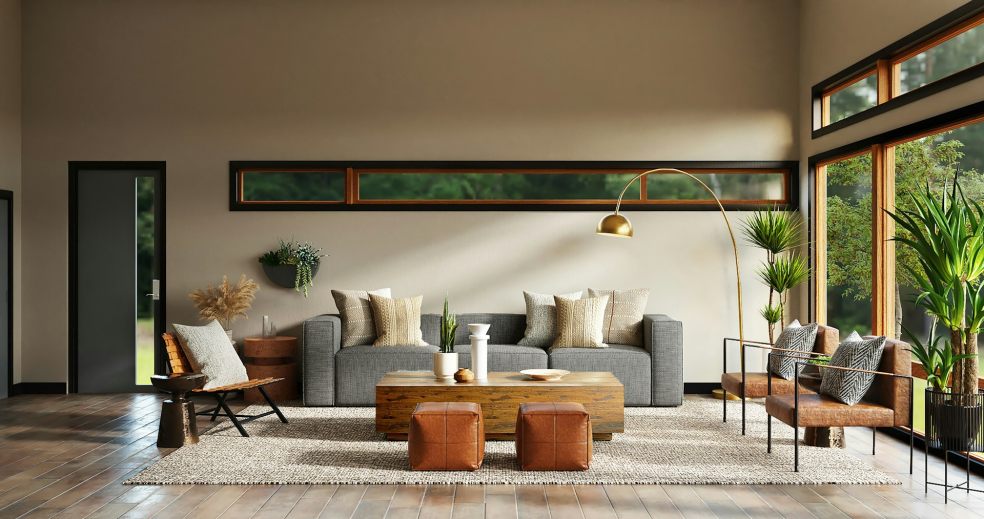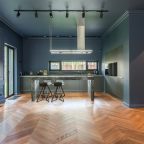
2025’s Top Interior Design Trends: What’s In and What’s Out
Interior design in 2025 is about striking a balance between personal expression and enduring quality. This year’s leading trends embrace tactile materials, natural influences, and a growing preference for nostalgic yet functional design. Here’s a breakdown of what’s gaining traction, and what’s being left behind.
Material drenching
One of the more sophisticated trends gaining momentum this year is material drenching. Similar in spirit to colour drenching (where a room is painted in varying shades of a single colour) this approach applies to texture and finish. Designers are wrapping entire spaces in a single material, whether that’s warm-toned woods, polished concrete, or natural plaster. The effect is enveloping and cohesive, helping to define the mood of a space while elevating its architectural features. It’s a bold move that’s best balanced with lighting and subtle decor layers.
Quiet luxury in the kitchen
The concept of “quiet luxury”—an understated elegance without visible branding—has now fully entered the home, especially the kitchen. Expect to see hidden appliances, seamless cabinetry, and richly grained woods like ash and oak. Instead of flashy features, designers are opting for tactile finishes and timeless craftsmanship. This trend reflects a broader cultural move toward quality over quantity, with kitchens designed to last decades rather than follow short-lived fads.
Minimaluxe vs. maximalism
Interestingly, 2025 continues to support both ends of the aesthetic spectrum. On one side, Minimaluxe – minimalism softened with luxurious materials and inviting textures (and first trendy in 2023 and 2024) – remains popular among those seeking calm, uncluttered spaces. Think curved sofas, boucle upholstery, and matte finishes.
On the flip side, maximalism is seeing a creative revival. Vibrant colour palettes, layered patterns, and eclectic accessories allow homeowners to showcase personality and a sense of humour. It's not just visual noise—it’s intentional curation. The common thread? Whether minimalist or maximalist, the focus is on authenticity.
Heritage elements are back
Another strong trend this year is the re-emergence of heritage styles. Dark wood furniture, traditional mouldings, and antique accents are finding their way into modern interiors. Often referred to as the “brown furniture” revival, this return to classical pieces is a direct reaction to years of flat-pack, disposable decor. Blending these elements with contemporary pieces results in spaces that feel grounded and unique.
Denim bedding and soft textures
Surprisingly, denim is having a moment in bedrooms. Designers are incorporating chambray and indigo-dyed linen to offer a casual, effortlessly cool look. These materials provide softness, durability, and a hint of Americana that complements rustic or modern farm-style interiors.
Organic curves and arches
Hard angles are being replaced with rounded shapes and organic silhouettes. From archways and curved door frames to sculptural furniture, these elements make interiors feel more fluid and inviting. Arches, in particular, serve as subtle architectural focal points that add depth without being overwhelming.
Earth tones lead colour palettes
Colour is taking a warmer turn in 2025. Gone are the cool greys and stark whites that dominated for over a decade. In their place: terracotta, olive green, ochre, and deep browns. These hues draw inspiration from nature and lend spaces a grounded, calming energy – perfect for homes that double as sanctuaries. For more of a natural touch, interior design plants can help create spaces that support our wellbeing.
What’s on the way out
As these new styles take hold, others are slipping out of favour. Overly industrial design, with its cold metals and raw finishes, is being softened or replaced. Open-concept layouts, once seen as modern and liberating, are now seen as impractical for privacy and acoustics. And while grey isn’t disappearing completely, it’s no longer the default backdrop for contemporary designs.
As the year unfolds, it’s clear that interior design in 2025 is driven by intention. Whether through vintage accents, warm palettes, or sculptural forms, the home is becoming more expressive – and far more personal.













